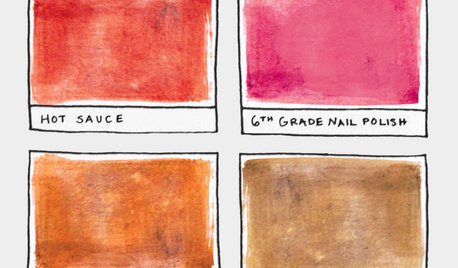So..What have you NOT learned yet
scottcalv
9 years ago
Related Stories

FUN HOUZZ16 Creative Paint Color Names We Haven't Seen — Yet
Someday, the namers of new paint colors will finally run out of ideas. We're here to help
Full Story
KITCHEN DESIGNChef's Kitchen Works Hard Yet Stays Pretty
A butler's pantry complete with refrigerator and dishwasher helps a restaurateur contain the mess when cooking and entertaining at home
Full Story
KIDS’ SPACES5 Ideas for a Great Home Learning Zone
Get your child off to a good start this school year with homework areas and strategies that reduce the frenzy
Full Story
FEEL-GOOD HOME12 Very Useful Things I've Learned From Designers
These simple ideas can make life at home more efficient and enjoyable
Full Story
REMODELING GUIDESSee What You Can Learn From a Floor Plan
Floor plans are invaluable in designing a home, but they can leave regular homeowners flummoxed. Here's help
Full Story
MOST POPULAR15 Remodeling ‘Uh-Oh’ Moments to Learn From
The road to successful design is paved with disaster stories. What’s yours?
Full Story
DECORATING GUIDES10 Design Tips Learned From the Worst Advice Ever
If these Houzzers’ tales don’t bolster the courage of your design convictions, nothing will
Full Story
WHITE KITCHENS4 Dreamy White-and-Wood Kitchens to Learn From
White too bright in your kitchen? Introduce wood beams, countertops, furniture and more
Full Story
DECORATING GUIDESPro to Pro: Learn Your Client’s Thinking Style
Knowing how someone thinks can help you determine the best way to conduct an interior design presentation
Full Story
FUN HOUZZEverything I Need to Know About Decorating I Learned from Downton Abbey
Mind your manors with these 10 decorating tips from the PBS series, returning on January 5
Full StorySponsored



Okiedawn OK Zone 7
scottcalvOriginal Author
Related Discussions
Have You Ordered any seeds/brugs Yet?
Q
winter sowing-have you started yet?
Q
Have you done this yet? I have!
Q
Have You Any JBs Yet?
Q
slowpoke_gardener
scottcalvOriginal Author
Okiedawn OK Zone 7
slowpoke_gardener
Okiedawn OK Zone 7
slowpoke_gardener
hazelinok
Okiedawn OK Zone 7
hazelinok
Okiedawn OK Zone 7
luvncannin
Okiedawn OK Zone 7
dbarron
hazelinok
Okiedawn OK Zone 7
slowpoke_gardener
Okiedawn OK Zone 7